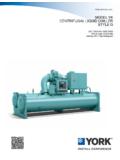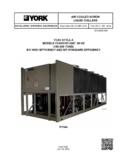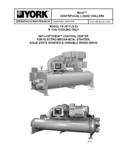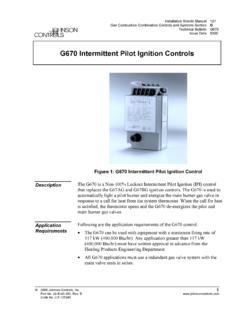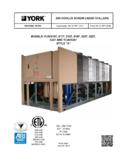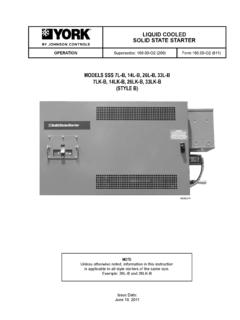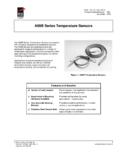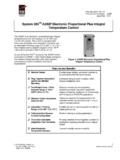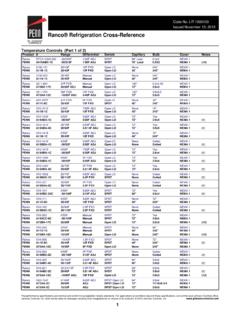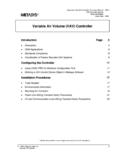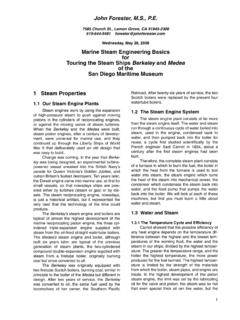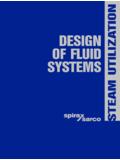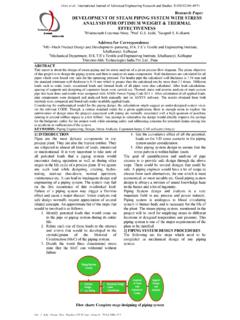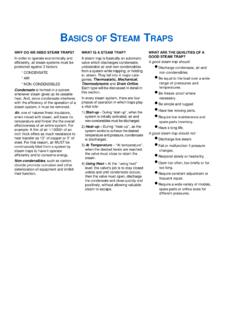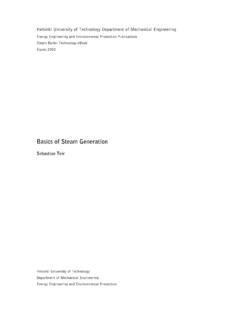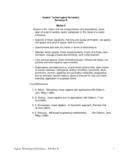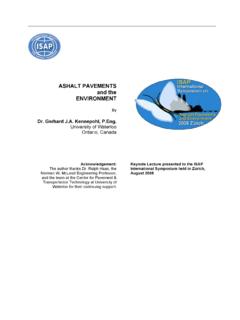Transcription of Section Vb1: Valves - Johnson Controls
1 Valve and Actuator Manual 977. Valve Basics and Sizing Information Section engineering Data Book Vb1. Issue Date 0294. Section Vb1: Valves Control Valves Page 3. Valve Components 3. Valve Parameters 5. Valve Flow Characteristic 5. Pressure Shift at Valve 6. Valve Gain 7. Valve Plugs 8. Rangeability 9. Cavitation 10. Coil Theory 13. Water Coils 13. Steam Coils 14. Valve Sizing 16. Valve Flow Coefficient 16. Pressure Drop Across the Valve 17. Sizing Water Valves 18. Examples 18. Solutions Other Than Water 19. Sizing Steam Valves 20. Examples 22. Gases Other Than Steam 23. Three Way Valves 23. Valve Selection Summary 25. Maximum Temperature and Pressure Ratings 29. Glossary 30. 1994 Johnson Controls , Inc. 1. Code No. LIT-347Vb 2 Vb1 engineering Data Book Valves Control Valves The valve is a controlled device that regulates the flow of a liquid or gas in a system. This regulation is accomplished by the varying resistance that the valve introduces into the system as the valve is stroked.
2 As the valve modulates to the closed position the system pressure drop shifts to the valve and reduces the flow in the system. The valve is very important to the operation of the system. Without a properly sized valve the system will never operate at an efficient level. For Valves that are oversized the result is poor controllability that may cause the system to hunt or cycle. Undersizing a valve will require a larger pressure drop across the valve to maintain adequate flow and may not provide required capacity. This results in the pump working harder and leaves the valve susceptible to the effects of cavitation. Valve Johnson Controls currently manufactures three different styles of globe Components valve. They are the VT series valve, the Cage Trim style valve, and the Iron Body Flange valve. The normally open versions of these Valves are shown in Figures 1, 2, and 3. For information on butterfly Valves consult the engineering Data Book Section Vb2: Butterfly Valves .
3 Vb1 engineering Data Book 3. All globe style Valves contain the same four basic sections; (1) Body, (2). Trim, (3) Bonnet, and (4) Actuator. The Body contains the orifice and is the main housing through which the controlled fluid flows. The Trim is the part of the valve excluding the body that comes in contact with the fluid. It is composed of the valve seat, plug, disc and disc holder, and stem. The Bonnet is an assembly that provides a mounting for the actuator and a guide through which the stem must pass. It is composed of the centerpiece, packing, packing guide, and packing nut. The packing provides a seal between the stem and bonnet to prevent leakage. The standard packing available on the current Valves is the EPDM (Ethylene Propylene Diene Monomer) Ring Pack as shown in Figure 4. Many of the discontinued JCI Valves used a Teflon or graphite packing. The Actuator consists of either pneumatic or electric means to provide the force to stroke the valve.
4 Consult Section Va: Valve Actuator in the engineering Data Book for further discussion. 4 Vb1 engineering Data Book Valve Parameters Valve Flow The factor that is most useful in selecting a valve type for a given Characteristic application is the flow characteristic. This characteristic is the relationship that exists between the flow rate through the valve and the valve stem travel as the latter is varied from zero to 100 percent. Different Valves have different flow characteristics, depending primarily on internal construction. This flow relationship is usually shown in the form of a graph as in Figure 7. The characteristic that is usually graphed is the Inherent Flow Characteristic that is found under laboratory conditions with constant pressure drop across the valve. The inherent equal percentage characteristic can be described by the following equation: Where: Q = Flow rate (GPM).
5 X = Valve Position (in.). T = Maximum Valve Travel (in.). Qm = Maximum Flow rate (GPM). R = Valve Rangeability (see Table II). These inherent flow characteristics are valuable for specifying a type of valve to be supplied by a manufacturer, but they do not reflect the actual performance of the valve once installed within a system. The pressure drop across the valve in the system is not constant; it varies with flow and other changes in the system. As the valve closes the pressure drop shifts to the valve and away from the other system components. This has a significant impact on the actual installed valve flow characteristic. The deviation from the inherent flow characteristic is a function of a property called Valve Authority. It is defined as the ratio of the full flow valve pressure drop to the system pressure drop (including the valve). N = Pvalve Psystem where: N = Valve Authority The actual characteristic when installed is known as the Installed Flow Characteristic.
6 The installed flow characteristic can be described by the following equation which is a function of valve authority and the inherent valve flow characteristic. Vb1 engineering Data Book 5. Pressure Shift at This change in pressure drop across the valve can be attributed to two Valve basic causes. 1) the pump characteristic, which results in an increase in pump head as the flow is reduced and 2) the reduction in line losses as the flow is reduced, causing more and more of the pump head to appear across the valve. The amount that the pump head will increase with a decrease in system flow will depend upon the operating characteristics of the pump. A pump with a steep characteristic will produce a considerable increase in pressure head as the system resistance is increased. However, a flat characteristic pump will produce a relatively constant, high pressure head for any system flow. The relatively constant pressure would be preferable from a control standpoint but the advantages and disadvantages of the many varieties of pumps are beyond the scope of this article.
7 This point where the system curve crosses the pump characteristic curve shows the operating conditions (flow and head) that will exist for this particular pump for a given system resistance (see Figure 5a). The system resistance is the combination of the pressure drop across the control valve and the other system components (coils, piping, balancing Valves , etc.). pressure drop. As the valve is closed on a system in full flow, the resistance to the system flow that the valve provides (valve pressure drop). will increase by shifting from point A towards point B (See Figure 5b). This increasing resistance will use more of the head in the system, as well as decrease system flow. The decrease in system flow will result in a decrease in pressure drop across every other component (coils, piping, balancing Valves , etc.) and leave additional pressure drop for the control valve. This is because the resistance of the components is proportional to the square root of the flow through them.
8 6 Vb1 engineering Data Book The effect of these system variables can be minimized by keeping the relative change in valve pressure drop as small as possible. Because the total pump head will appear across the valve when it is closed, the best way to keep the relative change as small as possible is to size the valve for as large a pressure drop as is permissible for the system. The larger percentage this initial pressure drop is of the total pump head, the smaller the relative change in pressure will be and the closer the valve installed flow characteristic will resemble its inherent flow characteristic. The desired result is to match a particular valve to a certain system. This could involve a very detailed analysis of the control loop. However, with a basic knowledge of Valves and a few generalizations the process can be greatly simplified. Valve Gain Valve gain is the incremental change in flow rate produced by an incremental change in plug position.
9 This gain is a function of valve size and type, plug configuration and system operating conditions. The gain at any point in the stroke of a valve is equal to the slope of the valve flow characteristic curve at that point. Vb1 engineering Data Book 7. Valve Plugs The shape of the valve plug determines the flow characteristic of the valve. (See Figure 7) Matching this plug flow characteristic to a particular control loop required that valve gain change in such a way as to compensate for the gain changes of the other elements (coil, balancing valve, piping, etc.) in the control loop. The valve gain is equal to the slope of the flow characteristic and is of primary significance in establishing the compatibility of the plug with the process. This will be shown graphically when valve and coil combinations are considered. The most common types of plugs are the equal percentage, linear, and quick opening plug.
10 Typically JCI offers the equal percentage characteristic. The idealized flow characteristics for these are shown in Figure 8. 8 Vb1 engineering Data Book The equal percentage valve plug produces the same percentage change in flow per fixed increment of valve stroke at any location on its characteristic curve. For example, if 30% stem lift produces 5 gpm and a lift increase of 10% to 40% produces 8 gpm or a 60% increase over the previous 5 gpm then a further stroke of 10% now produces a 60% increase over the previous 8 gpm for a total flow of gpm. (see Table I below.). The flow through a linear valve plug varies directly with the position of the valve stem. This type of valve plug is normally utilized in process control applications. They can be useful where it is desirable to control mass flow rates into and out of a process such as liquid level control. A quick opening valve plug produces a large increase in flow for a small initial change in stem travel.
